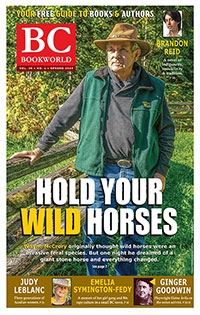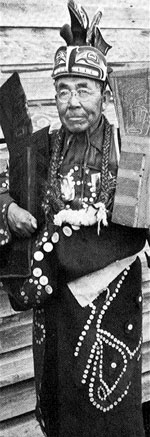"Willie Seaweed was born in a cedar plank house on the shores of an inlet that knew only canoe travel... and by the time he died unmanned space craft were landing on the moon." -- Michael M. Ames
Along with his fellow Kwakiutl artists Charlie James and Mungo Martin, and Haida artist Charles Edenshaw, Willie Seaweed provided an integral cultural link with the past, during much of the twentieth century, before Aboriginal artists and their work became widely accepted.
Born in Nugent Sound in approximately 1873, Seaweed became Chief Hilamas of the Nakwaktokw (or 'Nak'waxda'xw) tribe and a proponent of the potlatch during the years it was declared an illegal activity from 1884 to 1951. He also preserved his people's traditions as a sculptor, singer and storyteller.
The surname Seaweed is reportedly derived from his Aboriginal name Siwid meaning "Many Travel by Canoe to be at His Potlatches"; but it was more commonly translated as "Smoky-Top,"; as if to suggest a volcano.
Seaweed's carving was brought to prominence by Bill Holm with an exhibition at the Pacific Science Center in Seattle, Washington in 1983-1984 called Smoky-Top: The Art and Times of Willie Seaweed. From this exhibition arose a book featuring Seaweed's work, Smoky-Top, The Art and Times of Willie Seaweed (1983), followed by Innovations for a Changing Time: Willie Seaweed, A Master Kwakiutl Artist (1992). Seaweed's work was later displayed at the Vancouver Art Gallery in 1998 as part of an exhibition of wooden masks called Down from the Shimmering Sky.
In correspondence with Wilson Duff in 1955, Seaweed once described how and when his people moved to Blunden Harbour, a place on the mainland opposite the northern end of Vancouver Island. Known to his people as Ba'as, this village became widely associated with a famous painting of its waterfront by Emily Carr. Seaweed died at Blunden Harbour in 1967. A portrait of Seaweed by Mildred Valley Thornton appears in her Indian Lives and Legends.
BOOKS:
Smoky-Top, The Art and Times of Willie Seaweed (Thomas Burke Memorial Washington State Museum monograph) (University of Washington Press, 1983). By Bill Holm and Willie Seaweed.
Innovations for a Changing Time: Willie Seaweed, A Master Kwakiutl Artist (Seattle: Pacific Science Center, 1992).
[BCBW 2005]
Along with his fellow Kwakiutl artists Charlie James and Mungo Martin, and Haida artist Charles Edenshaw, Willie Seaweed provided an integral cultural link with the past, during much of the twentieth century, before Aboriginal artists and their work became widely accepted.
Born in Nugent Sound in approximately 1873, Seaweed became Chief Hilamas of the Nakwaktokw (or 'Nak'waxda'xw) tribe and a proponent of the potlatch during the years it was declared an illegal activity from 1884 to 1951. He also preserved his people's traditions as a sculptor, singer and storyteller.
The surname Seaweed is reportedly derived from his Aboriginal name Siwid meaning "Many Travel by Canoe to be at His Potlatches"; but it was more commonly translated as "Smoky-Top,"; as if to suggest a volcano.
Seaweed's carving was brought to prominence by Bill Holm with an exhibition at the Pacific Science Center in Seattle, Washington in 1983-1984 called Smoky-Top: The Art and Times of Willie Seaweed. From this exhibition arose a book featuring Seaweed's work, Smoky-Top, The Art and Times of Willie Seaweed (1983), followed by Innovations for a Changing Time: Willie Seaweed, A Master Kwakiutl Artist (1992). Seaweed's work was later displayed at the Vancouver Art Gallery in 1998 as part of an exhibition of wooden masks called Down from the Shimmering Sky.
In correspondence with Wilson Duff in 1955, Seaweed once described how and when his people moved to Blunden Harbour, a place on the mainland opposite the northern end of Vancouver Island. Known to his people as Ba'as, this village became widely associated with a famous painting of its waterfront by Emily Carr. Seaweed died at Blunden Harbour in 1967. A portrait of Seaweed by Mildred Valley Thornton appears in her Indian Lives and Legends.
BOOKS:
Smoky-Top, The Art and Times of Willie Seaweed (Thomas Burke Memorial Washington State Museum monograph) (University of Washington Press, 1983). By Bill Holm and Willie Seaweed.
Innovations for a Changing Time: Willie Seaweed, A Master Kwakiutl Artist (Seattle: Pacific Science Center, 1992).
[BCBW 2005]
Articles: 1 Article for this author
Background materials
Info
American Indian Art Magazine 19 (Spring 1994): 104. [reproduction]
Canadian Museum of Civilization, ed. In the Shadow of the Sun: Perspectives on Contemporary Native Art. Hull, Québec: The Museum, 1993.
Coe, Ralph. Sacred Circles. London, England: Arts Council of Great Britain, 1976.
Hawthorn, Audrey. Kwakiutl Art. Seattle, Washington: University of Washington Press, 1979.
Holm, Bill. The Box of Daylight: Northwest Coast Indian Art. Seattle, Washington: University of Washington Press, 1983.
Holm, Bill. "The art of Willie Seaweed, a Kwakiutl master." In The Human Mirror, Material and Spatial Images of Man, ed. Miles Richardson. Baton Rouge, Louisiana: Louisiana State University Press, 1974.
Holm, Bill. The Crooked Beak of Heaven: Masks and Other Ceremonial Art of the Northwest Coast. Seattle, Washington: University of Washington Press, 1972.
Holm, Bill. Northwest Coast Indian Art: An Analysis of Form. Seattle, Washington: University of Washington Press; Vancouver, British Columbia: Douglas & McIntyre, 1965.
Holm, Bill. Smoky-Top: The Art and Times of Willie Seaweed. Vancouver, British Columbia: Douglas & McIntyre, 1983.
Holm, Bill. Spirit and Ancestor: A Century of Northwest Coast Indian Art at the Burke Museum. Seattle, Washington: University of Washington Press, 1973.
Hoover, Alan L. "Charles Edenshaw: His art and audience." American Indian Art Magazine 20, no. 3 (Summer 1995): 44-53.
La Violette, Forest. The Struggle for Survival: Indian Cultures and the Protestant Ethic in British Columbia. Toronto, Ontario: University of Toronto Press, 1973.
Macnair, Peter, Alan Hoover, and Kevin Neary. The Legacy: Tradition and Innovation in Northwest Coast Indian Art. Vancouver, British Columbia: Douglas & McIntyre, 1984. Originally published: Victoria, BC: British Columbia
Provincial Museum, 1980.
Malin, Edward. Totem Poles of the Pacific Northwest Coast. Portland, Oregon: Timber Press, 1986.
Malin, Edward. Review of Smoky-Top: The Art and Times of Willie Seaweed by Bill Holm. American Indian Art Magazine 12 (Winter 1986): 69.
Stewart, Hillary. Looking at Indian Art of the Northwest Coast. Seattle, Washington: University of Washington Press, 1979.
Thornton, Mildred Valley. Indian Lives and Legends. Vancouver, British Columbia: Mitchell Press, 1966.
 Home
Home




